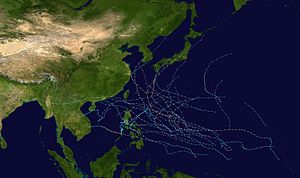1979 Pacific typhoon season
| 1979 Pacific typhoon season | |
|---|---|

Season summary map
|
|
| Seasonal boundaries | |
| First system formed | December 31, 1978 |
| Last system dissipated | December 23, 1979 |
| Strongest storm | |
| Name | Tip (Most intense tropical cyclone ever recorded) |
| • Maximum winds | 260 km/h (160 mph) (10-minute sustained) |
| • Lowest pressure | 870 hPa (mbar) |
| Seasonal statistics | |
| Total depressions | 55 |
| Total storms | 24 |
| Typhoons | 13 |
| Total fatalities | > 541 |
| Total damage | Unknown |
| Related articles | |
| Typhoon (JMA) | |
| Category 3 typhoon (SSHWS) | |
| Duration | December 31, 1978 – January 15, 1979 |
|---|---|
| Peak intensity | 175 km/h (110 mph) (10-min) 930 hPa (mbar) |
| Typhoon (JMA) | |
| Category 2 typhoon (SSHWS) | |
| Duration | March 19 – March 25 |
|---|---|
| Peak intensity | 130 km/h (80 mph) (10-min) 955 hPa (mbar) |
| Typhoon (JMA) | |
| Category 1 typhoon (SSHWS) | |
| Duration | April 10 – April 20 |
|---|---|
| Peak intensity | 140 km/h (85 mph) (10-min) 965 hPa (mbar) |
| Tropical storm (JMA) | |
| Tropical storm (SSHWS) | |
| Duration | May 9 – May 17 |
|---|---|
| Peak intensity | 75 km/h (45 mph) (10-min) 985 hPa (mbar) |
| Tropical storm (JMA) | |
| Tropical depression (SSHWS) | |
| Duration | May 17 – May 24 |
|---|---|
| Peak intensity | 75 km/h (45 mph) (10-min) 992 hPa (mbar) |
| Typhoon (JMA) | |
| Category 2 typhoon (SSHWS) | |
| Duration | June 29 – July 7 |
|---|---|
| Peak intensity | 140 km/h (85 mph) (10-min) 955 hPa (mbar) |
| Severe tropical storm (JMA) | |
| Tropical storm (SSHWS) | |
| Duration | July 1 – July 9 |
|---|---|
| Peak intensity | 100 km/h (65 mph) (10-min) 990 hPa (mbar) |
| Tropical depression (SSHWS) | |
| Duration | July 23 – July 27 |
|---|---|
| Peak intensity | 35 km/h (25 mph) (1-min) 1005 hPa (mbar) |
| Typhoon (JMA) | |
| Category 4 super typhoon (SSHWS) | |
| Duration | July 24 – August 8 |
|---|---|
| Peak intensity | 205 km/h (125 mph) (10-min) 900 hPa (mbar) |
The 1979 Pacific typhoon season has no official bounds; it ran year-round in 1979, but most tropical cyclones tend to form in the northwestern Pacific Ocean between June and December. These dates conventionally delimit the period of each year when most tropical cyclones form in the northwestern Pacific Ocean.
The scope of this article is limited to the Pacific Ocean, north of the equator and west of the international date line. Storms that form east of the date line and north of the equator are called hurricanes; see 1979 Pacific hurricane season. Tropical Storms formed in the entire west Pacific basin were assigned a name by the Joint Typhoon Warning Center. Tropical depressions in this basin have the "W" suffix added to their number. Tropical depressions that enter or form in the Philippine area of responsibility are assigned a name by the Philippine Atmospheric, Geophysical and Astronomical Services Administration or PAGASA. This can often result in the same storm having two names.
28 tropical depressions formed this year in the Western Pacific, of which 23 became tropical storms. 13 storms reached typhoon intensity, of which 4 reached super typhoon strength.
Very early on January 1 a tropical depression developed over the low latitudes of the open West Pacific. It tracked northwestward, reaching tropical storm strength that night and typhoon strength on the 5th. Alice turned to the west, and continued to intensify with generally favorable conditions to a peak of 125 mph winds on the 8th. Cooler, drier air to the north caused Alice to weaken to a minimal typhoon, but as the typhoon turned to the northwest it briefly re-strengthened to a 115 mph typhoon on January 11. Upper level winds, combined with the dry air, weakened Alice for good, causing it to dissipate on the 14th after stalling for three days. Alice caused extensive damage in the Marshall Islands.
Typhoon Bess was the third typhoon since 1959 to develop in the month of March. Bess began as a weak surface circulation on March 16. The circulation intensified into a tropical depression on March 19. Bess then reached tropical storm strength on March 21. Slow intensification occurred for 18 hours, before Bess reached its peak intensity of 105 mph (165 km/h) early on March 23. Bess held on to it"s peak intensity for 18 hours before vertical wind shear caused Bess to rapidly dissipate on March 25. Typhoon Bess remained away from land, and therefore caused no deaths or damage.
...
Wikipedia


















